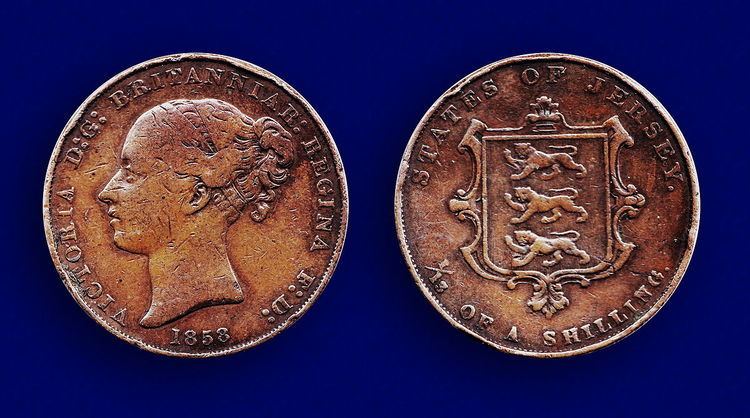Code JEP penny pence penny p | Symbol £ | |
 | ||
Obverse of a £5 banknote Reverse of a £5 banknote | ||
The pound is the currency of Jersey. Jersey is in currency union with the United Kingdom, and the Jersey pound is not a separate currency but is an issue of banknotes and coins by the States of Jersey denominated in pound sterling, in a similar way to the banknotes issued in Scotland and Northern Ireland (see Banknotes of the pound sterling). It can be exchanged at par with other sterling coinage and notes (see also sterling zone).
Contents
For this reason, ISO 4217 does not include a separate currency code for the Jersey pound, but where a distinct code is desired JEP is generally used.
Both Jersey and Bank of England notes are legal tender in Jersey and circulate together, alongside the Guernsey pound and Scottish banknotes. The Jersey notes are not legal tender in the United Kingdom but are legal currency, so creditors and traders may accept them if they so choose.
History
The livre was the currency of Jersey until 1834. It consisted of French coins which, in the early 19th century, were exchangeable for sterling at a rate of 26 livres = 1 pound. After the livre was replaced by the franc in France in 1795, the supply of coins in Jersey dwindled leading to difficulties in trade and payment. In 1834, an Order in Council adopted the pound sterling as Jersey's sole official legal tender, although French copper coins continued to circulate alongside British silver coins, with 26 sous equal to the shilling. Because the sous remained the chief small-change coins, when a new copper coinage was issued for Jersey in 1841, it was based on a penny worth 1⁄13 of a shilling, the equivalent of 2 sous. This system continued until 1877, when a penny of 1⁄12 of a shilling was introduced.
Along with the rest of the British Isles, Jersey decimalized in 1971 and began issuing a full series of circulating coins from ½p to 50p. £1 and £2 denominations followed later.
As of December 2005, there was £64.7m of Jersey currency in circulation. A profit of £2.8m earned on the issue of Jersey currency was received by the Treasurer of the States in 2005.
Coins
£1 coins have a different design each year. Initially, each new coin featured one of the coats of arms of the 12 parishes of Jersey. These were followed by a series of coins featuring sailing ships built in the island. The motto round the milled edge of Jersey pound coins is: Caesarea Insula ("island of Jersey" in Latin).
Jersey £1 coins will cease to be legal tender in Jersey on 15 October 2017 to coincide with the withdrawal of the circular £1 coin in the UK. The UK's new 12-sided £1 coin will be the only £1 coin that is legal tender in the Island.
History
In 1834, an Order in Council adopted the pound sterling as Jersey's sole official legal tender to replace the Jersey livre, although French copper coins continued to circulate alongside British silver coins, with 26 sous equal to the shilling. Because the sous remained the chief small-change coins, when a new copper coinage was issued for Jersey in 1841, it was based on a penny worth 1⁄13 of a shilling, the equivalent of 2 sous. In 1841, copper 1⁄52, 1⁄26 and 1⁄13 shilling coins were introduced, followed by bronze 1⁄26 and 1⁄13 shilling in 1866.
In 1877 a penny of 1⁄12 of a shilling was introduced, and the system changed to 12 pence to the shilling. Bronze 1⁄48, 1⁄24 and 1⁄12 shilling were introduced. This was the only issue of the 1⁄48 shilling denomination. Between 1949 and 1952 the end of the German occupation of the Channel Islands was marked by one million commemorative Liberation pennies that were struck for Jersey.
In 1957, a nickel-brass 3 pence coin was introduced carrying the denomination "one fourth of a shilling". The 1957 and 1960 issues were round, with a dodecagonal version introduced in 1964.
In 1968, 5 and 10 pence coins were introduced, followed by 50 pence in 1969 and ½p, 1p and 2 pence in 1971 when decimalisation took place. All had the same composition and size as the corresponding British coins. The reverse of the first issue of decimal coinage bore the coat of arms of Jersey as had previous coins. The ½ penny coin was last minted in 1981.
A square 1 pound coin was issued in circulation in 1981 to mark the bicentenary of the Battle of Jersey. The square pound could not be accepted by vending machines and was not issued after 1981 although it remains in circulation today. When the rest of the British Isles started to introduce a standardised pound coin in 1983, Jersey changed to a round coin to match. The square version although rare is still used in the islands. Neither round nor square versions of the coin are as common in Jersey as the 1 pound note.
20 pence coins were introduced in 1982 and 2 pound coins in 1998.
